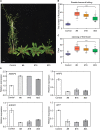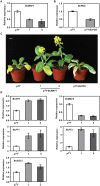Isolation and Functional Characterization of a Floral Repressor, BcMAF1, From Pak-choi (Brassica rapa ssp. Chinensis)
- PMID: 29559991
- PMCID: PMC5845726
- DOI: 10.3389/fpls.2018.00290
Isolation and Functional Characterization of a Floral Repressor, BcMAF1, From Pak-choi (Brassica rapa ssp. Chinensis)
Abstract
MADS-box genes form a large gene family in plants and are involved in multiple biological processes, such as flowering. However, the regulation mechanism of MADS-box genes in flowering remains unresolved, especially under short-term cold conditions. In the present study, we isolated BcMAF1, a Pak-choi (Brassica rapa ssp. Chinensis) MADS AFFECTING FLOWERING (MAF), as a floral repressor and functionally characterized BcMAF1 in Arabidopsis and Pak-choi. Subcellular localization and sequence analysis indicated that BcMAF1 was a nuclear protein and contained a conserved MADS-box domain. Expression analysis revealed that BcMAF1 had higher expression levels in leaves, stems, and petals, and could be induced by short-term cold conditions in Pak-choi. Overexpressing BcMAF1 in Arabidopsis showed that BcMAF1 had a negative function in regulating flowering, which was further confirmed by silencing endogenous BcMAF1 in Pak-choi. In addition, qPCR results showed that AtAP3 expression was reduced and AtMAF2 expression was induced in BcMAF1-overexpressing Arabidopsis. Meanwhile, BcAP3 transcript was up-regulated and BcMAF2 transcript was down-regulated in BcMAF1-silencing Pak-choi. Yeast one-hybrid and dual luciferase transient assays showed that BcMAF1 could bind to the promoters of BcAP3 and BcMAF2. These results indicated that BcAP3 and BcMAF2 might be the targets of BcMAF1. Taken together, our results suggested that BcMAF1 could negatively regulate flowering by directly activating BcMAF2 and repressing BcAP3.
Keywords: BcAP3; BcMAF1; BcMAF2; Pak-choi (Brassica rapa ssp. Chinensis); late flowering.
Figures






Similar articles
-
BcMAF2 activates BcTEM1 and represses flowering in Pak-choi (Brassica rapa ssp. chinensis).Plant Mol Biol. 2019 May;100(1-2):19-32. doi: 10.1007/s11103-019-00867-1. Epub 2019 Apr 18. Plant Mol Biol. 2019. PMID: 31001712
-
Isolation and functional characterization of a floral repressor, BcFLC2, from Pak-choi (Brassica rapa ssp. chinensis).Planta. 2018 Aug;248(2):423-435. doi: 10.1007/s00425-018-2891-0. Epub 2018 May 14. Planta. 2018. PMID: 29761290
-
BcAP3, a MADS box gene, controls stamen development and male sterility in Pak-choi (Brassica rapa ssp. chinensis).Gene. 2020 Jul 15;747:144698. doi: 10.1016/j.gene.2020.144698. Epub 2020 Apr 20. Gene. 2020. PMID: 32325091
-
Screening and functional verification of vernalization related transcription factor BrcFES1 in pak choi (Brassica rapa ssp. chinensis Makino).Plant Physiol Biochem. 2025 Jun;223:109887. doi: 10.1016/j.plaphy.2025.109887. Epub 2025 Apr 7. Plant Physiol Biochem. 2025. PMID: 40220668
-
Identification and Functional Characterization of a Cold-Related Protein, BcHHP5, in Pak-Choi (Brassica rapa ssp. chinensis).Int J Mol Sci. 2018 Dec 26;20(1):93. doi: 10.3390/ijms20010093. Int J Mol Sci. 2018. PMID: 30587842 Free PMC article.
Cited by
-
High expression of ethylene response factor BcERF98 delays the flowering time of non-heading Chinese cabbage.Planta. 2024 Jul 11;260(2):50. doi: 10.1007/s00425-024-04479-y. Planta. 2024. PMID: 38990341
-
Translating Flowering Time From Arabidopsis thaliana to Brassicaceae and Asteraceae Crop Species.Plants (Basel). 2018 Dec 16;7(4):111. doi: 10.3390/plants7040111. Plants (Basel). 2018. PMID: 30558374 Free PMC article. Review.
-
Long noncoding RNAs in Brassica rapa L. following vernalization.Sci Rep. 2019 Jun 26;9(1):9302. doi: 10.1038/s41598-019-45650-w. Sci Rep. 2019. PMID: 31243302 Free PMC article.
-
A single amino acid residue substitution in BraA04g017190.3C, a histone methyltransferase, results in premature bolting in Chinese cabbage (Brassica rapa L. ssp. Pekinensis).BMC Plant Biol. 2021 Aug 13;21(1):373. doi: 10.1186/s12870-021-03153-9. BMC Plant Biol. 2021. PMID: 34388969 Free PMC article.
-
A transcriptomic time-series reveals differing trajectories during pre-floral development in the apex and leaf in winter and spring varieties of Brassica napus.Sci Rep. 2024 Feb 12;14(1):3538. doi: 10.1038/s41598-024-53526-x. Sci Rep. 2024. PMID: 38347020 Free PMC article.
References
LinkOut - more resources
Full Text Sources
Other Literature Sources

